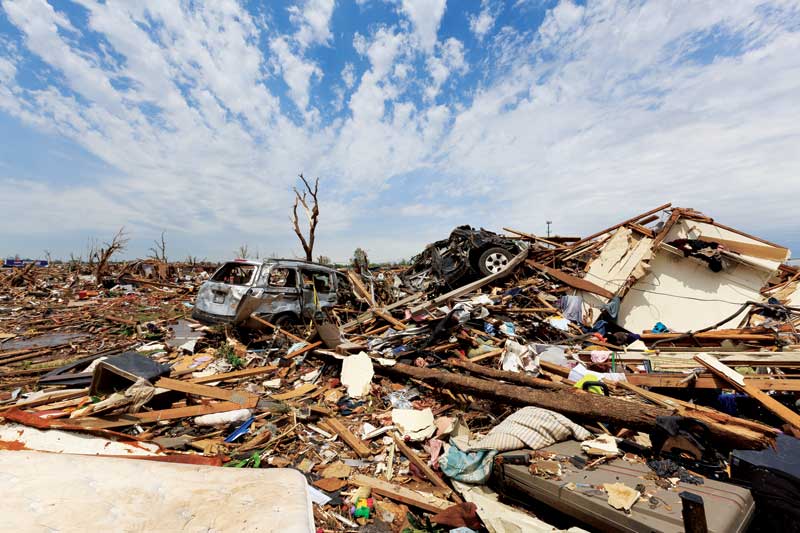Preparing for risk through resilience

Photo © Steve Zumwalt/FEMA
High winds and storms
Resilience in buildings and infrastructure is critical to keep people safe from storm damage due to hurricanes and tornados. As recently as 2011, two separate tornado outbreaks combined to cause $15 billion in damage in 21 states from Texas in to New York and into southern Canada, with especially deadly impacts in Alabama and Mississippi. If considered together, this pair of outbreaks would rank as the sixth-largest natural disaster in terms of insured-loss in U.S. history. (The “National Building Code Assessment Report,” by Insurance Services Office, was published earlier this year by Verisk Analytics). On April 27, 2011, some 219 tornadoes touched down in the United States, causing more than 300 fatalities. The outbreak resulted in tens of thousands of insurance claims and buildings being reduced to little more than debris. Hardest hit were structures of light building materials with inadequate connections to the buildings foundations.
Post-storm investigations show time and again adherence to effective building codes and construction best practices is critical for life safety and property protection in the face of high winds or tornadic activity. Small businesses and homes in areas subject to wind risk need to have safe rooms.
Guidance for builders of safe rooms is found in Federal Emergency Management Agency (FEMA) P320, Taking Shelter from the Storm Building a Safe Room for Your Home or Small Business. To protect groups of more than 16 people, communities, public spaces, commercial, and educational campuses need to have storm shelters to provide refuge in the face of these risks. Design professionals looking for technical guidance should refer to FEMA P361-2015, Safe Rooms for Tornadoes and Hurricanes: Guidance for Community and Residential Safe Rooms.
Even small changes to construction methods can pay huge benefits in the ability of a structure to weather the storm, explains the Federal Alliance For Safe Homes (FLASH) in its 2014 publication, Building Codes: The Foundation for Resilience. About 95 percent of wind damage occurs at EF-3 levels and below; 90 percent of tornadoes never grow to be more than an EF-2, with winds maxing out below 220 km/h (135 mph). Therefore, best practices—and the adoption of risk-based building codes such as requiring walls and roof assemblies be securely tied to concrete foundations—can go a long way in preventing damage and saving lives. When communities recognize the simple, yet profound, concept of mitigating risk though effective building codes, it changes the focus to cost-effective, smarter, not cheaper construction.
The economics of resilience
How can specifiers and designers educate clients about prevailing risk in their communities and the need to mitigate those risks through more resilient construction? FEMA recommends starting with the code. (FEMA’s “Building Codes Fact Sheet,” from July 2014, is available at www.fema.gov/media-library#). Through the Building Code Effectiveness Grading Schedule (BCEGS) program, Insurance Services Office works with state insurance regulators and individual building code enforcement officials to assess how effectively communities administer building codes, complete plan reviews and conduct field inspections.
The Insurance Services Office’s recently released “National Building Code Assessment Report” makes the compelling argument that reducing hazard based risk by investing in mitigation through retrofits and building to code reduces loss and saves money. Based on the program’s assessment (which places special emphasis on mitigation of risk due to natural hazards and fire), the Insurance Services Office provides participating communities with a classification between ‘1’ (i.e. exemplary commitment to building code enforcement) and ‘10.’
Communities are also given a comprehensive report detailing the factors comprising the classification. (To obtain the BCEGS classification and report for a particular community, one can contact the local building code official or city administrator.) Designers that recognize the value of resilient building may find it effective to cite a poor classification or lack of participation in BCEGS as a good reason for an owner to build beyond the minimum code standard.
It pays to be resilient. Studies of disaster events show “every dollar spent on mitigation saves four dollars in avoided future losses.” Programs like BCEGS help communities find their weak spots and where to invest. On the national level, the National Flood Insurance Program’s Community Rating System uses data from BCEGS to qualify communities to receive discounted flood insurance premiums. In this way, it rewards communities serious about code enforcement that take action to minimize their risk due to floods. FEMA uses BCEGS community classifications as a factor in determining how to distribute millions of dollars in mitigation grants through the Department of Homeland Security’s Pre-Disaster Mitigation Grant Program.
These sorts of initiatives go a long way to help communities become truly resilient and counter the ‘first-costs savings’ myth. In its report, “Developing Pre-disaster Resilience Based on Public and Private Incentivization,” the National Institute of Building Science’s (NIBS’) Multihazard Mitigation Council & Council on Finance, Insurance, and Real Estate has identified multiple ways to incentivize stakeholder groups from homeowners and business to utilities and municipalities to motivate them to build better. The report is summed-up in the following statement:
The most cost-effective manner to achieve resilience is through a holistic and integrated set of public, private, and hybrid programs based on capturing opportunities available through mortgages and loans; insurance; finance; tax incentives and credits; grants; regulations; and enhanced building codes and their application.
It is important to note both the private and public sectors have a role to play in this wrap-around approach. The private sector benefits through incentives that reduce and offset the cost of building to a higher standard, shrinking its risk and increasing the value of its investments. In much the same way, the public sector is better able to perform its primary duty to provide public safety by embracing resilience. It also facilitates lower insurance costs to its citizens all while saving $4 in disaster response cost for every $1 spent on mitigation. These communities enjoy the benefit of a healthier tax base as fewer businesses are shuttered and fewer community members financially impacted by disruptive events.








